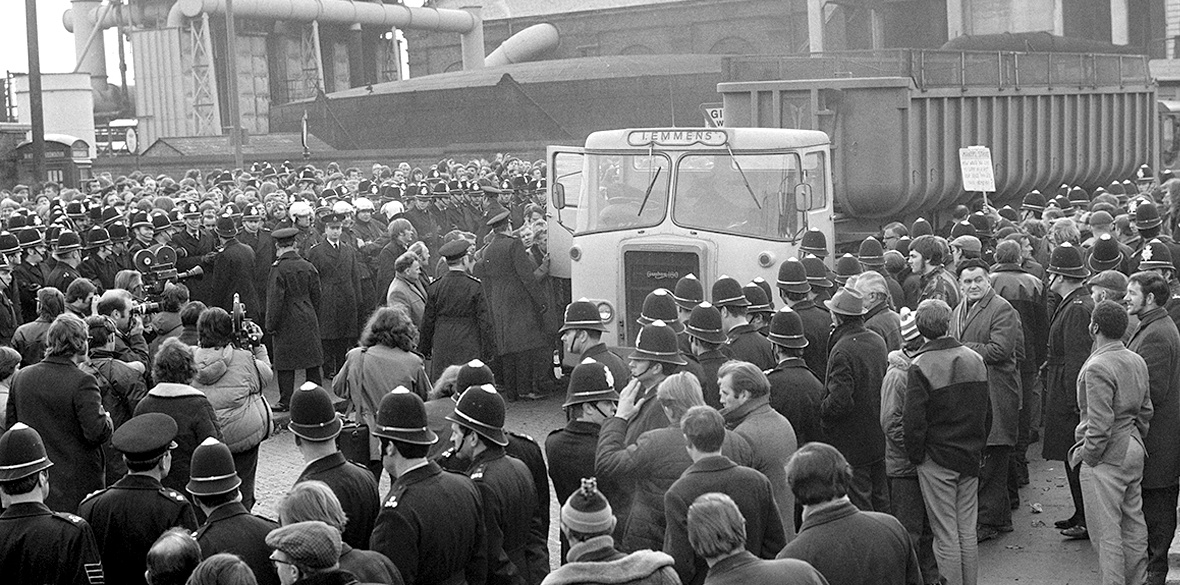This is the last article you can read this month
You can read more article this month
You can read more articles this month
Sorry your limit is up for this month
Reset on:
Please help support the Morning Star by subscribing here
GAS works have twice had a powerful impact on me. The first was a school visit in 1954 to the gas works at the east end of Eastbourne, Sussex (the site is now a Tesco supermarket).
It was a summer’s day but the experience of being enclosed inside the dark, cavernous coking plant is still fixed in my mind, as are the words of the Gas Board official who, as we toured the other facilities, extolled the scientific wonders of the distillation process which, apart from the coke, produced a multitude of by-products — coal tar, ammonia, dyes and much more.
Back then coal (or town) gas and its varied by-products sustained large sections of industrial activity, lit our streets, warmed our rooms and heated our food. Our society was still, as Orwell observed in his 1937 essay, Down The Mine, founded on coal.
Eighteen years later the extent to which the British economy was dependent on coal was put to the test when the National Union of Mineworkers (NUM) went on strike at midnight on January 8 1972.
By then the decade-long project to convert UK homes to North Sea gas, begun in 1967, was well underway and the dominance of coal as an energy source was displaced by the massive expansion of oil imports.
The Heath government and the media certainly thought the NUM was in for a hiding, with The Times predicting “only marginal disruption to industry and commerce as a whole.”
The Daily Mail was also clear: “It will hurt them more than it hurts us […] Few believe that the miners will stay out long enough to inconvenience the public.”
What happened is now history. Although the vote for a strike was 58.8 per cent — just over the 55 per cent required under the new rules agreed at the annual NUM conference in Aberdeen on July 6 1971 — all of the 280,000 miners in 289 mines came out in solid support.
Instead of passively picketing outside their pits, the miners fanned out over the country to target anywhere coal was distributed or consumed. Power stations, ports and coal depots were blockaded.
As Arthur Scargill — one of the key organisers at the time — pointed out, the clear intention was “to attack the vulnerable points. They were the points of energy: the power stations, the coke depots, the coal depots, the points of supply.”
The tactic of flying pickets developed by the Yorkshire miners in the unofficial strikes of 1969 and 1970 now transferred onto the national arena. These actions, supported by students, other trade unionists and the general public, were extremely effective and coal stocks were sharply reduced.
After relatively mild weather a cold spell at the end of January revealed the impact the miners were having as they steadily cut off the supply of coal and coke across the country.
The Central Electricity Generating Board reduced voltage right across the national grid and three power stations shut down completely. It was clear that the coal-fired economy was beginning to crumble.
And so, for a second time, events around another gas works played a formative role in my life. Fifty years after Saltley Gate these are my eyewitness recollections of the events leading up to the stunning experience of industrial solidarity which occurred there.
In August 1971 I went to Birmingham to work for the International Socialists (IS), forerunner to what is now the Socialist Workers Party.
In the first week of the 1972 miners’ strike I looked at the map for the nearest pits, and drove up to Rugeley in Staffordshire with a young unemployed IS member, John Brown. We made contact with miners from Lee Hall Colliery who were picketing the Rugeley ‘A’ and ‘B’ power stations. Two of the younger miners were interested in what we had to say and got involved, coming down to speak at meetings we organised in Birmingham and the Black Country in support of the strike.
The West Midlands Gas Board coke depot between Saltley and Nechells in Birmingham escaped the attention of the Midlands NUM for the first two weeks of the strike.
The day before the stoppage, on an inside page of the Birmingham Sunday Mercury among other strike-related stories, there was a report of a Gas Board official confirming that there were coke stocks of at least 100,000 tons at the Board’s Windsor Street depot in Saltley. “We would be willing to sell the coke to coal merchants, subject to loading facilities being available,” he said.
This seemed to breach the guidelines agreed between the government and the NUM to supply only priority customers such as hospitals and the vulnerable, but the Gas Board argued that these did not apply because, unlike other coke depots such as the Coalite plant at Grimethorpe, this one belonged to another industry not involved in the strike.
The result was that by the beginning of February several hundred lorries from all over England and Wales were queuing from early morning outside the depot, and on February 3 the Birmingham Evening Mail ran a feature on the queues, accompanied by photos of the lines of lorries.
The Midlands NUM secretary, Jack Lally, had tried and failed to negotiate with the Gas Board for over a fortnight. On Friday February 4 he despatched pickets to the coke depot but their efforts to stop lorries was limited.
More pickets came to Birmingham in response to calls from the NUM national office, including Arthur Scargill, who on Saturday night drove down to Birmingham and met Frank Watters, the Communist Party organiser at the Star Club, the Communist Party HQ and bookshop on Essex Street in the city centre.
All sorts of elements within Birmingham’s trade union structures came together to ensure the final victory at Saltley.
I want to mention Alan Law, the full-time official of the TGWU road haulage branch 5/35. I remember branch meetings, when important issues came up, taking place not in some poky room in a pub but in a cinema in Newtown, Birmingham.
Law had a reputation in the media reminiscent of the former US leader of the Teamsters, Jimmy Hoffa, because strike action by his members could swiftly disrupt the West Midlands economy and beyond.
At Saltley members of his branch played a key role, as Watters writes in his memoirs, Being Frank: “Alongside organising a round-the-clock rota of pickets, the 5/35 branch of the T&G, with its full-time officer, Alan Law, was concerned about the welfare of the hundreds of miners we now had to provide accommodation for.
“They arranged for 200 beds to be found by their own members. Another gesture, as I have said, was to send a lorry-load of steak and kidney pies. Such an abundance of good food not only brought a lift to morale on the picket line, but I will never forget seeing strike-breaking lorries driving into the coke depot with steak and kidney pies dripping from the drivers’ faces.”
As TGWU lorry drivers heeded pickets and turned away, non-union firms were used with the drivers paid £50-£60 per day plus a £50 bonus for every load.
From Monday February 7 each day saw an escalation with more miners and supporters on the picket line but also more police with clear instructions to keep the gates open and let the lorries through. Decisive and broader solidarity action was needed.
Andy Beckett’s informative chapter Close The Gates in When The Lights Went Out (2009) covers these momentous events in Birmingham. Beckett keeps referring to Roger Harper. He really means Arthur Harper, convenor of Tractors and Transmissions, a British Leyland plant on Drews Lane in north-east Birmingham.
Its 4,800 workers had the distinction in the early ’70s of being among the highest paid and best organised in the sprawling British Leyland group run at the time by Lord Stokes. Arthur was also president of the Amalgamated Union of Engineering Workers (AUEW) Birmingham East district committee.
He was a small, stocky, barrel-chested, strongly built man who wore a tight-fitting suit, walked with a confident strut and spoke with a strong Black Country accent which, he told me, was deliberately thickened as a negotiating ploy with management. He also proudly wore his paratrooper wings in his jacket lapel outside work. Inside he wore his blue overalls.
In February 1972 Harper played a crucial role in the mobilisation of Birmingham engineering workers in support of the beleaguered miners, which culminated in the police closing the gates to the Nechells coke depot on February 10 1972.
By a coincidence of timing, a regular meeting of the AUEW East district committee on February 8 was a key wheel in the cog which drove forward solidarity action. Harper as Chair ruled that Scargill be allowed to speak, and he made a 40-minute passionate appeal and won the committee’s support.
The next day an emergency district shop stewards’ quarterly was called and 300 stewards endorsed an appeal by Harper to lead demonstrations to Saltley. Two other key unions, the TGWU and National Union of Vehicle Builders, took similar decisions to support solidarity action.
I was at Saltley pretty much continuously from February 7 through February 10 but after all the arrests, ebbs and flows in terms of the battle between pickets, scab lorry drivers and the police, what happened that Thursday morning (Feb 10) was out of this world, an experience that you cannot erase.
As over 6,000 engineering workers marched over the hill behind their union banners chanting “Close the Gates” the chief constable of Birmingham, Sir Derrick Capper, bowed to the inevitable and at sometime between 10.42 and 10.45 — accounts vary, and to be honest clock-watching was the furthest thing on my mind at that point — ordered the gates closed.
Capper later said: “That day was the worst day of my life.” Harper’s response was, “Funnily enough, it was my happiest since I had been demobbed.”
It was Watters, I think, who described Saltley as “the icing on the cake” of the 1972 miners’ strike. By then the Heath [Conservative] government knew that the game was over and the miners were on their way to winning a great strike which erased the memories of 1926.
On a trivial personal note, I have only one regret about those momentous days at Saltley. For my 18th birthday my mother used her “divi” to go to the Co-operative department store (long since demolished) at the bottom of the Moor in Sheffield and bought me a stylish, light-coloured Crombie coat.
On Wednesday February 9, amid the swirling pickets and police, I was suddenly pulled from behind as a policeman grabbed hold of my coat. He managed to neatly rip it down the seams at the back as I fell to the ground. Foolishly I didn’t think about getting it stitched together again. It went in a bin.
Before Saltley, Scargill had begun to establish a regional reputation as an articulate, militant Yorkshire miner during the unofficial strikes of 1969 and 1970. He was 34 when Saltley dramatically projected him on to the national arena both in the trade union movement and the media.
Granville Williams edits MediaNorth (http://medianorth.org.uk) and edited Shafted: The Media, the Miners’ Strike and the Aftermath (2nd ed) 2019










